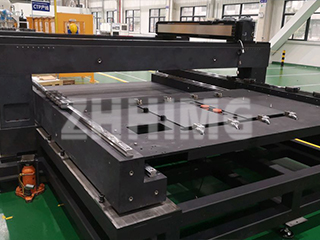Granite platforms, known for their high durability and precision, are essential in various industrial applications. However, drilling holes in granite can be challenging due to its hardness and rigidity. To ensure clean and accurate holes without damaging the surface, it’s important to follow the right techniques and tools. Here’s a step-by-step guide on how to drill holes in granite platforms safely and effectively.
Methods for Drilling Holes in Granite Platforms
-
Using a Hammer Drill (Non-Impact Mode)
When using a hammer drill, make sure the drill’s setting is switched to non-impact mode. This will allow for slow and steady drilling, which is essential to avoid cracking or damaging the granite surface. It’s important to avoid drilling too close to the edges of the granite to prevent any chipping or cracking. This method is ideal for drilling smaller holes. -
Using a Hollow Core Drill for Glass
For cleaner holes, a hollow core drill designed for glass or ceramic materials can be used. While drilling, apply consistent pressure and use water for cooling. It’s crucial to avoid applying excessive force, as this can cause the drill bit to overheat and wear down quickly. Water helps to dissipate heat and prevents the drill bit from burning out. -
Using Carbide-Tipped Drill Bits
Carbide-tipped drill bits are another excellent choice for drilling in granite. Similar to the hammer drill method, the drill setting should be switched to non-impact mode. When drilling with carbide-tipped bits, ensure that the hole is not placed too close to the edge of the granite to minimize the risk of cracks. This method works well for smaller diameter holes.
Key Tips for Drilling in Granite
-
Use Water for Cooling
Always use water during the drilling process to keep the drill bit cool. Dry drilling can quickly damage the drill bit and cause it to lose effectiveness. Water cooling also reduces the risk of heat buildup, which can affect the quality of the hole and potentially crack the granite. -
Properly Position and Secure the Granite
Ensure that the granite platform is level and securely fixed in place before drilling. The impact from the drill can cause vibrations that may lead to cracks or breakage if the stone is not properly supported. Use clamps or a sturdy surface to prevent movement during drilling. -
Avoid Over-Pressure
When drilling in granite, always apply even and moderate pressure. Excessive force can cause the drill bit to overheat and reduce its lifespan. By applying consistent pressure and allowing the drill to work at its own pace, you ensure a smoother and cleaner hole.
Granite Characteristics and Durability
Granite is a high-performance material known for its exceptional strength and longevity. Here are some key properties that make granite an ideal choice for industrial use:
-
Non-Deformable
Granite is formed through natural geological processes, giving it a uniform structure and a very low coefficient of thermal expansion. This means granite doesn’t deform over time, maintaining its shape and accuracy in various environments. -
High Hardness and Wear Resistance
Granite has a high hardness rating, which contributes to its excellent wear resistance. It is highly durable and can withstand heavy-duty use without significant wear or damage, making it ideal for demanding industrial applications. -
Long Service Life
Granite platforms require minimal maintenance. Unlike other materials that may need oiling or special care, granite platforms are easy to maintain, do not attract dust, and can retain their physical properties for an extended period. The durability of granite ensures that it will last for many years with minimal wear. -
Scratch Resistance
Granite platforms do not easily scratch, maintaining their smooth surface even after long periods of use. This makes granite an ideal material for precision tools and measurement instruments. -
Non-Magnetic
Granite is non-magnetic, which is crucial for applications that require non-interfering surfaces. It allows for smooth movement during measurements without any magnetic disturbances, ensuring accuracy and reliability. -
Stable at Room Temperature
Granite remains stable at room temperature, and its physical properties do not change under normal conditions. This makes it an excellent choice for measurement tools that need to maintain precision in varied environments.
Conclusion: Drilling and Maintaining Granite Platforms
Drilling holes in granite platforms requires precision and the right techniques. By using the correct tools, applying consistent pressure, and following safety measures like water cooling, you can ensure a successful drilling process. With granite’s exceptional durability and resistance to wear, it remains one of the best materials for high-precision industrial applications.
If you need granite platforms for your operations or require further guidance on drilling techniques, contact us today. We offer high-quality granite solutions that ensure long-lasting performance and precision.
Post time: Aug-07-2025

